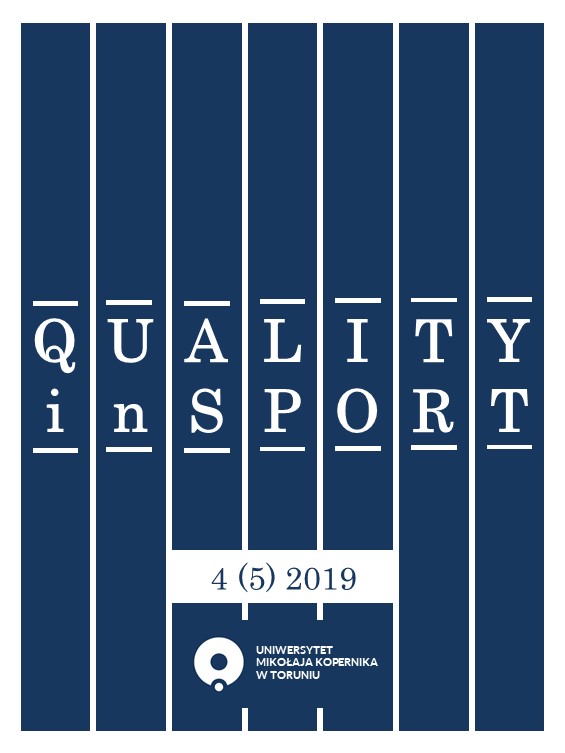Development of Triple jump Learning Model Based Audiovisual for Physical Education Students of Sebelas Maret University
DOI:
https://doi.org/10.12775/QS.2019.025Keywords
Development, Triple Jump Learning, Physical EducationAbstract
Abstract
This research aims to
This research aims to make the product of triple jump learning model based on audio visual in learning athletics in Physical Education of Sebelas Maret University.The method used is Research and Development. Instrument used are interview, questionnare and test. The subject of this research includes the athletic instructor number triple jump and students in Physical Education of Sebelas Maret University. The technique of collecting data uses interview the instructor number triple jump, test and student respons for learning model product, evaluation also validation from the expert and documentation. Analysing data through collecting data, exploring data, reducing data, presenting data, and verifying data. The product of learning model of triple jump has been analysed the media expert with the results 90%, the expert of triple jump material gives score 90,42% and practician gives score 92,91%. The product fulfills the “Valid” criteria and can be used by the students in learning process. The little scale of the trial which was done by the 15 students got the result 88,27% The large scale of trials which was done by 25 students got the results 91,12%. P-Value is less than the standard number of signification 0,000 < 0,005%. The conclusion result of those control and experiment groups shows the significant result. The control group that has used the conventional method cc74,4 centi meter with the percentation about 35%, while the treatment group that has used the last product of triple jump learning model increases significantly about 137,5 centi meter, almost double from control group that gets percentation about 65%. Based on the result which has been gotten, thererefore the product of triple jump learning model based on audio visual is effective to be implemented.
make the product of triple jump learning model based on audio visual in learning athletics in Physical Education of Sebelas Maret University.The method used is Research and Development. Instrument used are interview, questionnare and test. The subject of this research includes the athletic instructor number triple jump and students in Physical Education of Sebelas Maret University. The technique of collecting data uses interview the instructor number triple jump, test and student respons for learning model product, evaluation also validation from the expert and documentation. Analysing data through collecting data, exploring data, reducing data, presenting data, and verifying data. The product of learning model of triple jump has been analysed the media expert with the results 90%, the expert of triple jump material gives score 90,42% and practician gives score 92,91%. The product fulfills the “Valid” criteria and can be used by the students in learning process. The little scale of the trial which was done by the 15 students got the result 88,27% The large scale of trials which was done by 25 students got the results 91,12%. P-Value is less than the standard number of signification 0,000 < 0,005%. The conclusion result of those control and experiment groups shows the significant result. The control group that has used the conventional method increases 74,4 centi meter with the percentation about 35%, while the treatment group that has used the last product of triple jump learning model increases significantly about 137,5 centi meter, almost double from control group that gets percentation about 65%. Based on the result which has been gotten, thererefore the product of triple jump learning model based on audio visual is effective to be implemented.
Keywords: Development, Triple Jump Learning, Physical Education
References
Adi, Winendra. Dkk. 2008. Seri Olahraga Atletik. Yogyakarta: Pustaka Insan Madani.
Agus. S. Suryosubroto. 2001. Teknologi Pembelajaran Pendidikan Jasmani. Yogyakarta: Fakultas Ilmu Keolahragaan.
Asutay, Hikmet. 2007. “İnternet Ile Yeni Medyalarda Çocuk ve Gençlik Yazını”, Trakya Üniversitesi Sosyal Bilimler Dergisi, Cilt 9, Sayı 2.
Borg W.R., & Gall M.D. 2007. Educational Research: Instructor’s Manual and Test Bank (8th Ed.). New York: Pearson.
Gerry A. Carr. 1997. Atletik Untuk Sekolah. Jakarta. PT Raja Grafindo Persada.
Sudjono, Anas. 2013. Pengantar Evaluasi Pendidikan. Jakarta: Rajawali Press.
Sugiyono. 2016. Metode Penelitian dan Pengembangan: Research and Development. Bandung: CV. Alfabeta.
Tarik Yazar, Gocke. 2012. A Research of Audio Visual Educational Aids on The Creativity Levels of 4-14 Year Old Children as A Process in Primary Education. Procedia Social and Behavioral Sciences.Scie Verse Science Direct.
Taras HL, Sallis JF, ve Nader PR. 1990. Childrens Television-Viewing Habits And The FamilyEnvironment. AJDC 144: 357-359.
Downloads
Published
How to Cite
Issue
Section
Stats
Number of views and downloads: 361
Number of citations: 0



